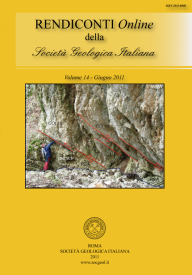
Assetto strutturale della catena a pieghe e sovrascorrimenti Umbro-Sabina (Italia Centrale) derivato dal rilevamento dei fogli 366 "Palombara Sabina" e 375 "Tivoli" (Progetto CARG)
Andrea Bollati (*), Sveva Corrado (*), Domenico Cosentino (*), Maurizio Marino (**), Massimo Mattei (*) & Maurizio Parotto (*)
(*) Dipartimento Scienze Geologiche, Università Roma Tre, Largo San Leonardo Murialdo 1, 00146 Roma, Italy. E-mail: andrea_bollati@fastwebnet.it
(**) ISPRA, Istituto Superiore per la Protezione e la Ricerca Ambientale, Via Curtatone 3, 00185 Roma, Italy.
Volume: 14/2011
Pages: 37-61
Abstract
Structural Scheme of the Umbria-Sabina fold-and-thrust belt (Central Italy) derived from the geological mapping of 366 "Palombara Sabina" and 375 "Tivoli" sheets (CARG Project).
The geological mapping of the sheets 366 "Palombara Sabina" and 375 "Tivoli" (1: 50.000 scale; CARG Project; in preparation) allowed the revision of the structural setting of the westernmost portion of this part of the Neogene fold-and-thrust belt of the Central Apennines.
The area comprises the Cornicolani, Lucretili, eastern Sabini, Tiburtini, Ruffi and Prenestini Mts (Latium region). Most of the area (Cornicolani, Lucretili and Tiburtini Mts) is made of the pre-orogenic deposits (Upper Triassic-Serravallian) referred to the calcareous-marly-siliceous Sabina Succession, that were accumulated in the southern part of the Umbria-Marche-Sabina Pelagic Basin (Sabina Domain), proximal to the Latium-Abruzzi Carbonate Platform. In general, in the eastern areas, more proximal to the platform, coarser lithofacies crop out. Moreover, in the Cornicolani and western Lucretili Mts (Castelvecchio Mt) areally restricted outcrops of condensed pelagic carbonates (Bugarone Group and calcari dolomitici di S. Angelo Romano) document the occurrence of Jurassic intrabasinal structural highs evolved into Pelagic Carbonate Platforms. These structural highs were generated after the Early Jurassic rifting, that broke-up the pre-existing carbonate platform (Calcare Massiccio).
In the mapped area, the Latium - Abruzzi Platform is represented in the hangingwall of the Olevano-Antrodoco line only in the southern Prenestini Mts (Rocca di Cave), by upper Cretaceous shelf carbonates. Whereas in the footwall of the Olevano-Antrodoco line it crops out along the Aniene River valley.
Both Sabina and Latium - Abruzzi successions are overlain by upper Tortonian - lower Messinian marls and siliciclastic syn-orogenic deposits, best observed in the easternmost areas and inbetween the Ruffi and Prenestini Mts.
In their turn, the syn-orogenic deposits are unconformably overlain by post-orogenic Plio-Pleistocene marine clastic deposits and Quaternary volcanic and alluvial sediments. From a structural point of view, the Sabina Domain is arranged into several thrust sheets verging toward the east, developed in middle-late Miocene-early Pliocene times. The early Pliocene Olevano-Antrodoco out-of-sequence thrust marks the eastern tectonic boundary of this structural domain where the pelagic and slope sediments overthrust the Latium - Abruzzi Carbonate Platform and its associated syn-orogenic deposits. In late Miocene-early Pliocene extensional tectonics down-threw the western border of this imbricated structure enhancing the marine ingression along the peri-Tyrrhenian margin. The western border of the region was also reactivated by N-S right-lateral strike-slip fault dissecting the earlier structures in Pleistocene times.
From top of the orogenic edifice three main tectonic units have been identified:
- Unit 1 (Morra Mt) made up of Upper Triassic to Lower Jurassic dolomite limestones (Dolomia Principale) and Calcare Massiccio, overthrust onto unit 2.
- Unit 2 (comprising Cornicolani Mts, western Lucretili Mts) made up of Dolomia Principale, Calcare Massiccio, Corniola detritica and, in the Cornicolani and western Lucretili Mts, Bugarone Group. Long wavelength upright folds mainly characterize this unit and faults with high angle cuts-offs prevail, and Jurassic structural highs occur (Cornicolani Mts, Castelvecchio Mt).
- Unit 3 (comprising Elci Mt, eastern Lucretili Mts and Tiburtini Mts) made up of most of the Sabina basin stratigraphic succession - from Corniola detritica Fm. to the Guadagnolo Member (marly lithofacies); the unit is characterized by NW to NE verging overturned to recumbent folds.
- Unit 4 (comprising Prenestini Mts, Ruffi Mts and eastern Sabini Mts) made up of the upper portion of the basin succession between the Marne a Fucoidi and Upper Miocene siliciclastics and the Rocca di Cave carbonate platform succession.
This unit is made up by two sub-units, based on the deformation-style and stratigraphy: the sub-unit 4A (Granaro Mt, Colle Serviano and Arzillo Mt in the western Prenestini Mts), is mainly characterized by east-verging packed asymmetrical folds with sub-vertical axial-planes, and N-S striking dextral-transpressive faults. The sub-unit 4B (Castel Madama area, eastern and central Prenestini Mts, Ruffi Mts and eastern Sabini Mts) is characterized by a wide symmetrical anticline in the western portion, and by folds with very steep axial planes, and N-S to NNW-striking dextral transpressional faults.
The units are separated by low-angle thrusts or by high-angle transpressive faults: the stratigraphic successions characterizing each unit rejuvenate eastward.
The innermost unit 1 and unit 2, where massive or poorly stratified deposits are exposed, are mainly deformed by high angle faults. Whereas the more external unit 3 and unit 4 are composed by alternating carbonate, marls and siliciclastics, and are mostly characterized by east-verging slightly to strongly asymmetrical and overturned folds.
A new geometric and kinematic scenario for the Neogene evolution of the units preserved in the hangingwall of the Olevano-Antrodoco thrust is here outlined.
The revision of the stratigraphy and structural data put in evidence the presence of paleo-structures of the Tethyan passive margin not evidenced in the past cartography, their influence on Neogene compressive structures and the coexistence of non-coaxial structural trends in areas of limited extension.
Keywords
CARG Project, structural setting, Central Apennines, Sabina Domain, structural highs, Neogene evolution
Get Full Text